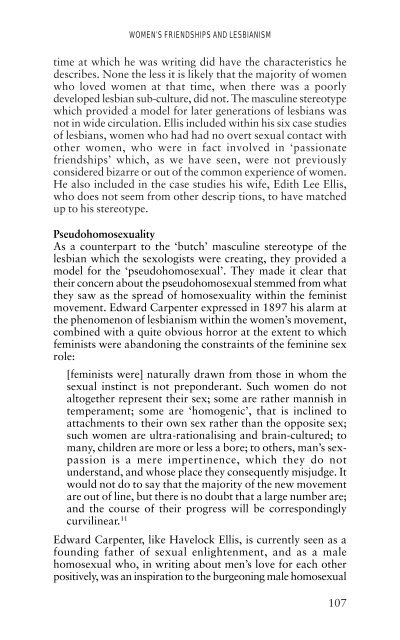The Spinster and Her Enemies - Feminish
The Spinster and Her Enemies - Feminish
The Spinster and Her Enemies - Feminish
You also want an ePaper? Increase the reach of your titles
YUMPU automatically turns print PDFs into web optimized ePapers that Google loves.
WOMEN’S FRIENDSHIPS AND LESBIANISM<br />
time at which he was writing did have the characteristics he<br />
describes. None the less it is likely that the majority of women<br />
who loved women at that time, when there was a poorly<br />
developed lesbian sub-culture, did not. <strong>The</strong> masculine stereotype<br />
which provided a model for later generations of lesbians was<br />
not in wide circulation. Ellis included within his six case studies<br />
of lesbians, women who had had no overt sexual contact with<br />
other women, who were in fact involved in ‘passionate<br />
friendships’ which, as we have seen, were not previously<br />
considered bizarre or out of the common experience of women.<br />
He also included in the case studies his wife, Edith Lee Ellis,<br />
who does not seem from other descrip tions, to have matched<br />
up to his stereotype.<br />
Pseudohomosexuality<br />
As a counterpart to the ‘butch’ masculine stereotype of the<br />
lesbian which the sexologists were creating, they provided a<br />
model for the ‘pseudohomosexual’. <strong>The</strong>y made it clear that<br />
their concern about the pseudohomosexual stemmed from what<br />
they saw as the spread of homosexuality within the feminist<br />
movement. Edward Carpenter expressed in 1897 his alarm at<br />
the phenomenon of lesbianism within the women’s movement,<br />
combined with a quite obvious horror at the extent to which<br />
feminists were ab<strong>and</strong>oning the constraints of the feminine sex<br />
role:<br />
[feminists were] naturally drawn from those in whom the<br />
sexual instinct is not preponderant. Such women do not<br />
altogether represent their sex; some are rather mannish in<br />
temperament; some are ‘homogenic’, that is inclined to<br />
attachments to their own sex rather than the opposite sex;<br />
such women are ultra-rationalising <strong>and</strong> brain-cultured; to<br />
many, children are more or less a bore; to others, man’s sexpassion<br />
is a mere impertinence, which they do not<br />
underst<strong>and</strong>, <strong>and</strong> whose place they consequently misjudge. It<br />
would not do to say that the majority of the new movement<br />
are out of line, but there is no doubt that a large number are;<br />
<strong>and</strong> the course of their progress will be correspondingly<br />
curvilinear. 11<br />
Edward Carpenter, like Havelock Ellis, is currently seen as a<br />
founding father of sexual enlightenment, <strong>and</strong> as a male<br />
homosexual who, in writing about men’s love for each other<br />
positively, was an inspiration to the burgeoning male homosexual<br />
107

















